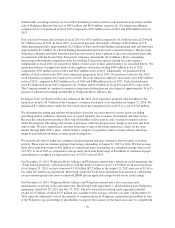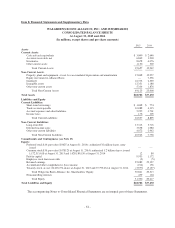Walgreens 2015 Annual Report Download - page 61
Download and view the complete annual report
Please find page 61 of the 2015 Walgreens annual report below. You can navigate through the pages in the report by either clicking on the pages listed below, or by using the keyword search tool below to find specific information within the annual report.
OFF-BALANCE SHEET ARRANGEMENTS
We do not have any unconsolidated special purpose entities and, except as described herein, we do not have
significant exposure to any off-balance sheet arrangements. The term “off-balance sheet arrangement” generally
means any transaction, agreement or other contractual arrangement to which an entity unconsolidated with us is a
party, under which we have: (i) any obligation arising under a guarantee contract, derivative instrument or
variable interest; or (ii) a retained or contingent interest in assets transferred to such entity or similar arrangement
that serves as credit, liquidity or market risk support for such assets.
At August 31, 2015, we have issued $482 million in letters of credit, primarily related to insurance obligations.
We also had $10 million of guarantees to various suppliers outstanding at August 31, 2015. The Company
remains secondarily liable on 71 leases. The maximum potential undiscounted future payments related to these
leases was $351 million at August 31, 2015.
RECENT ACCOUNTING PRONOUNCEMENTS
In August 2015, the Financial Accounting Standards Board (FASB) issued Accounting Standards Update (ASU)
2015-15, Interest – Imputation of Interest (subtopic 835-30). This ASU provides additional guidance on ASU
2015-03, Interest – Imputation of Interest. These ASUs require debt issuance costs to be presented in the balance
sheet as a direct deduction from the carrying amount of the debt liability, consistent with debt discounts or
premiums and further specify debt issuance costs as part of line-of-credit arrangements should be treated in the
manner described above. Recognition and measurement guidance for debt issuance costs are not affected. These
ASUs are effective for annual periods beginning after December 15, 2015 (fiscal 2017). As permitted, the
Company early adopted ASU 2015-03 beginning in the third quarter of fiscal 2015. The impact of this ASU
reduced non-current assets and long-term debt by $20 million at August 31, 2014, respectively. This ASU has no
impact on the statement of earnings or statement of cash flows. The additional guidance provided in ASU 2015-
15 had no material financial statement impact.
In August 2015, the FASB issued ASU 2015-14, Revenue from Contracts with Customers (Topic 606), an update
to ASU 2014-09. This ASU amends ASU 2014-09 to defer the effective date by one year for annual reporting
periods beginning after December 15, 2017 (fiscal 2019). Early adoption is permitted for annual reporting
periods beginning after December 15, 2016 (fiscal 2018). ASU 2014-09 provides a new revenue recognition
standard with a five-step analysis of transactions to determine when and how revenue is recognized. The core
principle is that a company should recognize revenue to depict the transfer of promised goods or services to
customers in an amount that reflects the consideration to which the entity expects to be entitled in exchange for
those goods or services. The Company is evaluating the effect of adopting this new accounting guidance.
In July 2015, the FASB issued ASU 2015-11, Inventory (Topic 330). This ASU simplifies current accounting
treatments by requiring entities to measure most inventories at “the lower of cost and net realizable value” rather
than using lower of cost or market. This guidance does not apply to inventories measured using last-in, first-out
(LIFO) method or the retail inventory method (RIM). This ASU is effective prospectively for annual periods
beginning after December 15, 2016 and interim periods thereafter (fiscal 2018) with early adoption permitted.
Upon transition, entities must disclose the accounting change. The Company is evaluating the effect of adopting
this new accounting guidance but does not expect adoption will have a material impact on the Company’s results
of operations, cash flows or financial position.
In November 2014, the FASB issued ASU 2014-17, Pushdown Accounting. This ASU provides companies with
the option to apply pushdown accounting in its separate financial statements upon occurrence of an event in
which an acquirer obtains control of the acquired entity. The election to apply pushdown accounting can be made
either in the period in which the change of control occurred, or in a subsequent period. This ASU is effective as
of November 18, 2014. The adoption did not have a material impact on the Company’s results of operations, cash
flows or financial position.
-57-
























